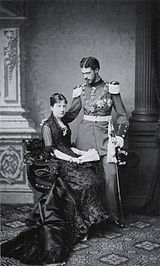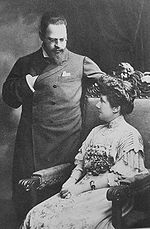Infanta María de la Paz of Spain
| Infanta María de la Paz | |||||
|---|---|---|---|---|---|
 Infanta Paz in 1907 | |||||
| Born | 23 June 1862 Madrid, Spain | ||||
| Died | 4 December 1946 (aged 84) Nymphenburg Palace, Munich, Bavaria, Germany | ||||
| Burial | |||||
| Spouse | |||||
| Issue | |||||
| |||||
Francisco, Duke of Cádiz | |||||
| Mother | Isabella II | ||||
Infanta María de la Paz of Spain (23 June 1862 – 4 December 1946) was a Spanish
Early life
Born at the
According to historians, the true biological father of Infanta Paz was the diplomat and politician Miguel Tenorio de Castilla (1818–1916), who was secretary of Queen Isabella II for several years.[2][3][4]
Infanta Paz probably also suspected that Tenorio de Castilla was her natural father. In 1890, in his old age, Tenorio de Castilla settled in a suite on the south wing of Nymphenburg Palace, Paz’s residence. He lived there for twenty-six years until his death on 11 December 1916.[4] He bequeathed all his belongings to Infanta Paz, who accepted them as his universal heir.[4][5]
Infanta Paz was baptized by the archbishop of Toledo with the names María de la Paz Juana Amelia Adalberta Francisca de Paula Juana Bautista Isabel Francisca de Asís. Her godmother was her paternal aunt

In 1868, when she was only six years old, Paz and her family were forced to leave Spain by the revolution (the "
In 1874, Paz’s brother King
Of Queen Isabella’s five children to survive infancy, Paz was the one who resembled their mother most closely. Paz was short and plain with a small upward nose and a mischievous look in her small eyes. Unlike her sisters Isabel and Eulalia, Paz did not have a strong personality. She was uncomplicated, friendly and accommodating. Romantic and artistic, she was very fond of writing poems and was also a skillful painter. As a child, she studied the history of Spain, and she always remained interested in this subject. In later years, she wrote articles published in the newspaper ABC. She was also musical; she played the harp, and enjoyed songs by Paolo Tosti, as well as the operas of Giuseppe Verdi and Charles Gounod. She was also a devoted Catholic.
Marriage

By the spring of 1880, plans were made to marry Infanta Paz to her first cousin
When Infanta Paz finally met Ludwig Ferdinand in the autumn of 1880, she found him unattractive and did not wish to marry him. Paz rebuffed the proposed marriage, but Ludwig Ferdinand did not abandon his intentions. In January 1883, Ludwig Ferdinand returned to Spain to ask for Paz's hand in marriage. While walking together in the gardens of La casa de campo on January 22, 1883, he proposed and Paz accepted.[7] The marriage took place in the chapel of the Royal Palace of Madrid on 2 April 1883. Paz retained her rights to the Spanish crown and received an annuity of 150,000 pesetas.[10] She was twenty years old. Among her gifts was the Bavarian sunburst tiara,[11] which remained in the princely family until it was sold at auction in 2013.[12]
Move to Bavaria
On their way to
Children
The marriage of Infanta Paz and Prince Ludwig Ferdinand was long and happy. They had three children. The eldest,
- Maria Teresa, daughter of Alfonso XIIof Spain.
- Prince Adalbert of Bavaria(1886–1970). He was a historian and diplomat. He married Countess Augusta of Seefried and had two sons. They lived in Germany.
- Princess Pilar of Bavaria (1891–1987), unmarried. She worked as a painter.
Life in Bavaria

Paz's husband Prince Ludwig Ferdinand was a great music lover who played the violin with the Munich royal orchestra.
In Munich, Paz dedicated a great deal of her time to charity work.
From Bavaria, Infanta Paz followed the life of her Spanish family through letters from her sister Isabel. Paz's only brother King Alphonso XII died young in 1886. Paz maintained a warm relationship with her sister-in-law
In 1914, Infanta Paz made a journey by car to Salamanca, León, Oviedo, Covadonga and the Cantabrian coast, accompanied by the Marquis de la Vega de Anzo, her sister Infanta Isabel and her daughter Princess Pilar. At the outbreak of World War I in August that year, she stayed in Nymphenburg. Her son Adalbert, who was chief of artillery, joined the German forces. Her sister Eulalia was a frequent visitor, and she was a great help after the devastation caused by World War I
Last years
After the war and the fall of the Bavarian monarchy, Infanta Paz and her family were allowed to keep on living in Nymphenburg Palace. The family fortune was drastically reduced, but Paz still had income as a member of the Spanish royal family. She made sporadic visits to Spain. While in Madrid, she and her husband stayed at the royal palace.[18] Paz also owned a rural property in Cuenca that she had inherited from her grandmother Queen Maria Cristina and the house of the Dukes of Riánsares in Tarancón, where she used to spend long sojourns enjoying the dry fields of La Mancha.[18] Nearby, she bought a rural estate called Saelices that her husband transformed into a model of agricultural farming. It was bought years later by the bullfighter Luis Miguel Dominguín. In October 1928, Paz went to the small town of Santillana del Mar, which she had visited previously in 1881, and the town council gave her a house to spend summers there.
Paz, whose name means "peace" in Spanish, honored her name in observance of pacifism. She took part in pacifist congresses of 1921 in Paris, 1923 in Friburg, 1924 in London, 1926 in Luxembourg and 1926 in Bierville, France.[18]
Following the overthrow of her nephew Alphonso XIII in 1931, Paz lost her Spanish-derived income. Her life in Germany became more restricted with the arrival of
In 1945, American troops entered Munich. Soldiers ransacked Paz's house and took with them some jewellery that Paz had inherited from her mother that turned out to be fake.
In 1946, Paz accidentally fell down some stairs and died some hours later.
Author
Infanta Paz wrote the following books:
- Cuatro revoluciones e intermedios: Setenta años de mi vida. Memorias de la Infanta Paz. Espasa-Calpe, Madrid, 1935.[19] Published in English as Through Four Revolutions: 1862–1933.
- Aus meine Leben: Erinnereungen von Prinzessin Ludwig Ferdinand von Bayern (Munich, Georg Muller, 1917)[19]
- De mi vida. Impresiones (Madrid, 1909), De mi vida. Impresiones (Salamanca, 1911)
- Buscando las huellas de Don Quijote (Freiburg, 1905).[19]
- Emmanuela Theresa von Orden St. Clara, tochter des Kurfürsten Max Emanuel von Bayern 1696–1750 (Munich, 1902, published in German and in French ).[19]
- Poesías (Freiburg,1904), Roma eterna (Munich, 1922).[19]
She also translated the historical books written by her son Prince Adalbert from German to Spanish. Paz's personal diary was drawn upon by her son, who in taking some passages from it and adding extracts from her letters to members of her family, published a book with the title Through Four Revolutions: 1862–1933.
Honours and arms
Orders and decorations
 Spain:
Spain:
- Dame of the Order of Queen Maria Luisa, 26 June 1862[20]
- Grand Cross of the Civil Order of Alfonso XII, 16 January 1914[21]
Arms
- Heraldry of María de la Paz of Spain
-
Coat of arms of Infanta Paz, Princess in Bavaria (Bavaria)
-
Coat of Arms of Infanta Paz (as Infanta of Spain)
Ancestry
| Ancestors of Infanta María de la Paz of Spain | ||||||||||||||||||||||||||||||
|---|---|---|---|---|---|---|---|---|---|---|---|---|---|---|---|---|---|---|---|---|---|---|---|---|---|---|---|---|---|---|
| ||||||||||||||||||||||||||||||
References
- ^ Puga, 20 infantas de España, p. 133
- ^ Cierva, Alfonso y Victoria , p. 261
- ^ Vidal Sales, Francisco de Asís de Borbón y Borbón, p. 168
- ^ a b c Rey y Cabieses, Wittelsbach y Borbón, p. 15
- ^ Vidal Sales, Francisco de Asís de Borbón y Borbón , p. 169
- ^ Rey y Cabieses, Wittelsbach y Borbón, p. 16
- ^ a b Rey y Cabieses, Wittelsbach y Borbón, p. 18
- ^ Rey y Cabieses, Wittelsbach y Borbón, p. 17
- ^ Infanta Paz, Cuatro revoluciones e intemedios , p. 88
- ^ Infanta Paz, Cuatro revoluciones e intemedios , p. 103
- ^ "The Bavarian Sunburst Tiara". A Tiara a Day.
- ^ "MAGNIFICENT JEWELS AND NOBLE JEWELS". Sothebys.
- ^ Rey y Cabieses, Wittelsbach y Borbón, p. 20
- ^ a b Rey y Cabieses, Wittelsbach y Borbón, p. 21
- ^ a b Rey y Cabieses, Wittelsbach y Borbón, p. 24
- ^ Rey y Cabieses, Wittelsbach y Borbón, p. 25
- ^ a b c Rey y Cabieses, Wittelsbach y Borbón, p. 22
- ^ a b c Rey y Cabieses, Wittelsbach y Borbón, p. 28
- ^ a b c d e f Rey y Cabieses, Wittelsbach y Borbón, p. 29
- ^ "Real Orden de la Reina Maria Luisa", Guóa Oficial de España (in Spanish), 1929, p. 861, retrieved 3 April 2021
- ^ "Orden Civil de alfonso XII", Guóa Oficial de España (in Spanish), 1929, p. 861, retrieved 3 April 2021
Bibliography
- Aronson, Theo. Venganza real: la Corona de España, 1829–1965. Ed.Grijalbo, 1968.
- Infanta Paz; Cuatro revoluciones e intemedios: Setenta años de mi vida. Espasa-Calpe, Madrid, 1935.
- Infanta Eulalia; Memorias de Doña Eulalia de Borbón, Infanta de España (1864–1931). Ed. Juventud, 1954.
- Baviera, S.A.R. Princesa Pilar de; Chapman-Huston, Comandante Desmond. Alfonso XIII. Col. "Z"
- Puga, Maria Teresa; 20 infantas de España: Sus vidas, entre las ilusiones y el destino. Ed. Juventud, Barcelona, 1998.
- Rey y Cabieses, Amadeo-Martín, Wittelsbach y Borbón: Relaciones y Enlaces Entre las Casas Reales de Baviera y de España, Siglos XIX Al XXI, Consejo Superior de Investigaciones Científicas, 2005
- Vidal Sales, José Antonio; Francisco de Asís de Borbón y Borbón: la peripecia íntima, secreta y sentimental del esposo de Isabel II, un rey consorte afeminado y blando. Ed. Planeta, 1995
External links
![]() Media related to Infanta María de la Paz of Spain at Wikimedia Commons
Media related to Infanta María de la Paz of Spain at Wikimedia Commons


